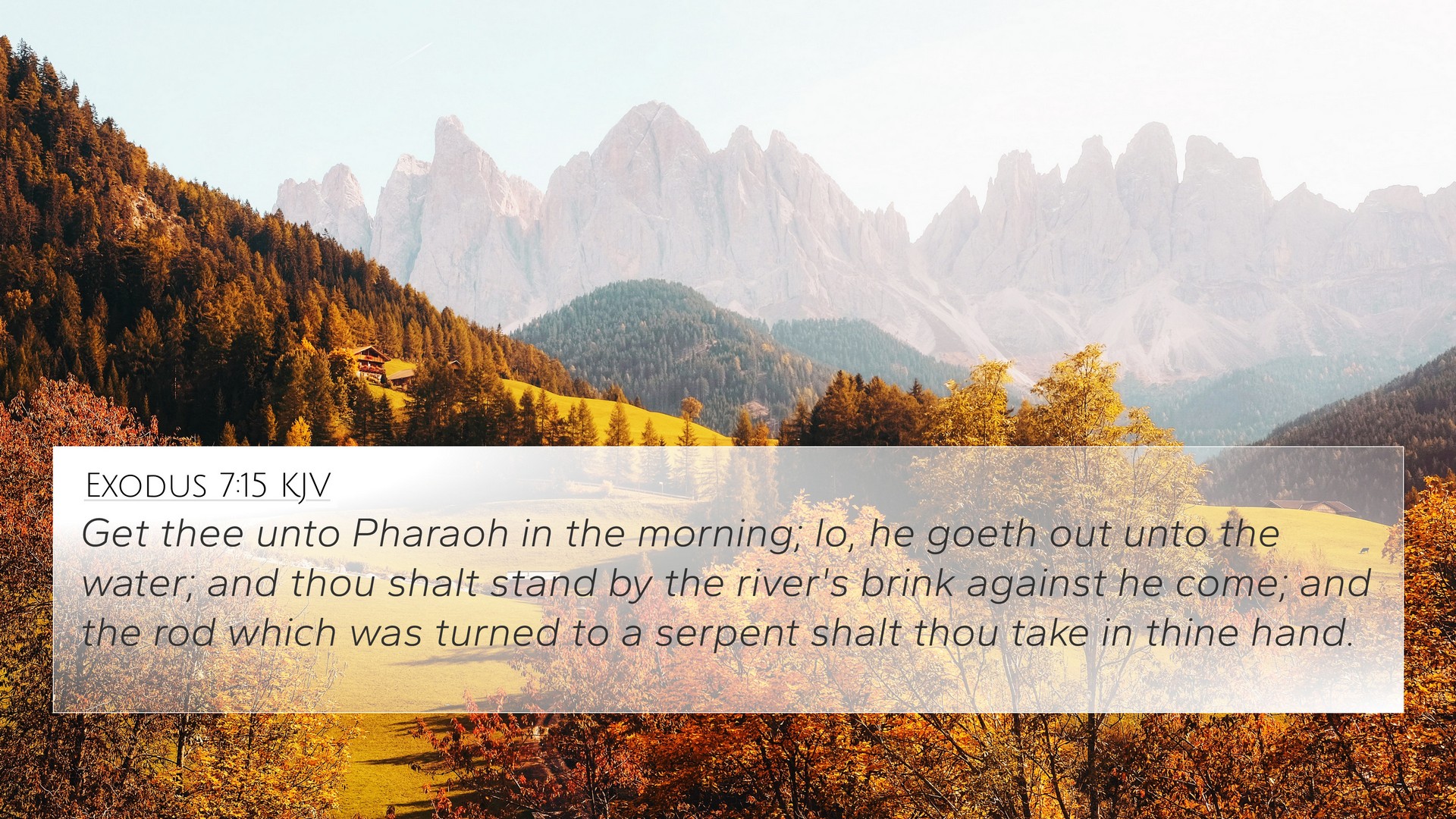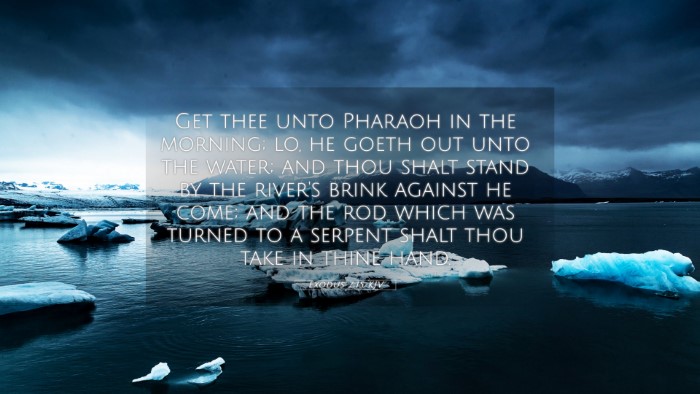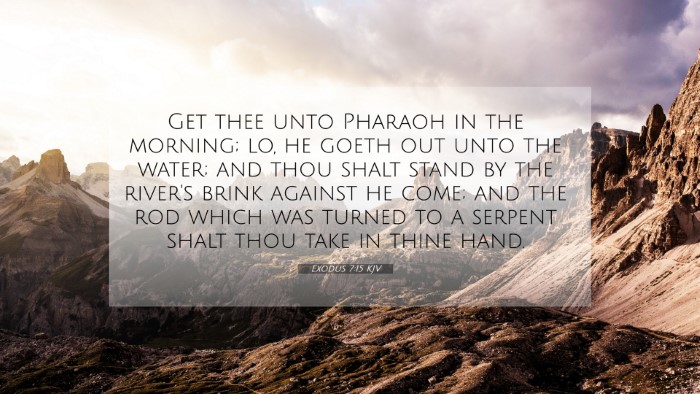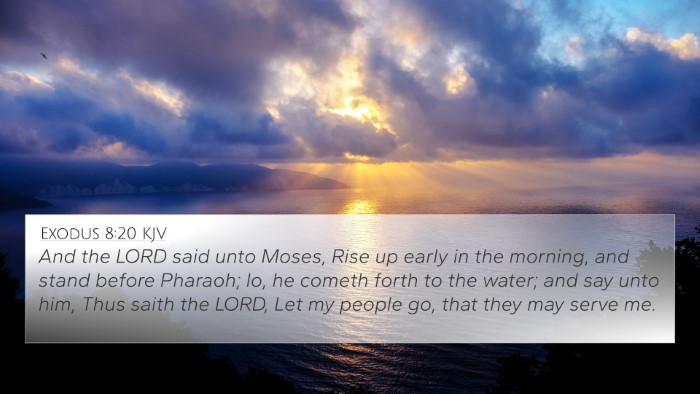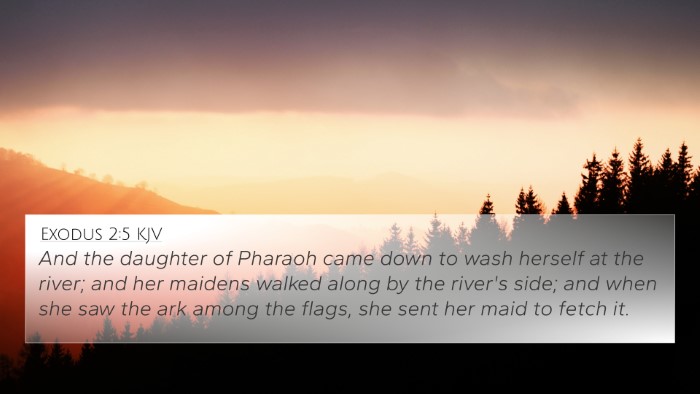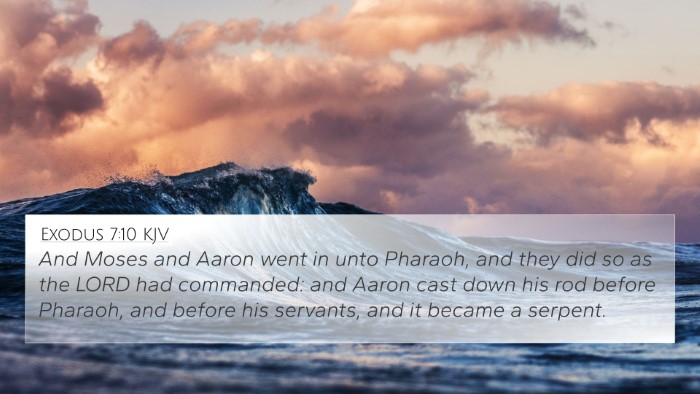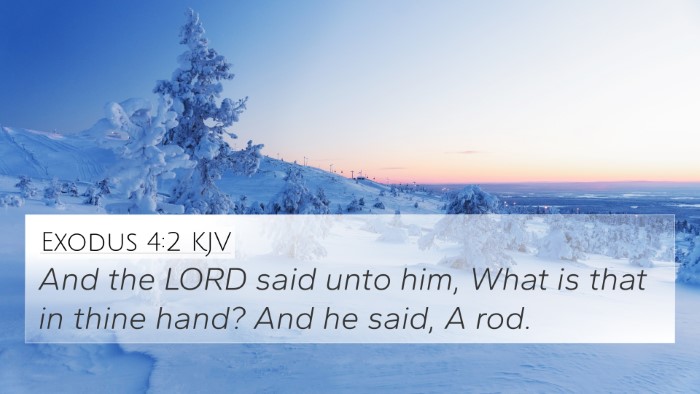Understanding Exodus 7:15
Exodus 7:15 states: "Go to Pharaoh in the morning; lo, he goes out to the water; and you shall stand by the river's brink against he come; and the rod which was turned to a serpent shall you take in your hand." This verse captures a significant moment in the narrative of Moses and Pharaoh, emphasizing God's authority and the unfolding of divine events in Egypt.
Summary of Key Themes
- Divine Instruction: The verse highlights God's command to Moses, emphasizing obedience in carrying out His will.
- Confrontation with Pharaoh: The encounter signifies the challenge of authority between God and Pharaoh, representative of earthly power.
- Symbolism of the Rod: The rod transformed into a serpent symbolizes God's power over nature and His ability to perform miracles.
Insights from Public Domain Commentaries
This analysis integrates perspectives from Matthew Henry, Albert Barnes, and Adam Clarke, aiming to provide a comprehensive understanding of the verse.
Matthew Henry's Commentary
Matthew Henry emphasizes the significance of the morning visit, symbolizing a new beginning or a confrontation that God orchestrates. He notes that God's direction to Moses indicates the importance of divine timing and readiness to fulfill God's directive, reinforcing the theme of faith as Moses prepares to confront Pharaoh.
Albert Barnes' Notes
Albert Barnes highlights the promise of God's presence and power. He elaborates on the importance of the rod turning into a serpent as a demonstration of God's might, suggesting that this display was both a warning and an invitation for Pharaoh to acknowledge God's sovereignty. Barnes also underscores the literal setting by the Nile, which was symbolic of Egyptian life and would carry significant impact when God intervenes.
Adam Clarke's Commentary
Adam Clarke provides a deep dive into the contextual background. He explains the cultural significance of the Nile River and how Moses' presence there was both a direct challenge to Egyptian deities associated with the river and a miraculous sign meant to captivate Pharaoh’s attention. Clarke also discusses the expected reaction of Pharaoh and the broader narrative of liberation for the Israelites.
Bible Cross-References
Exodus 7:15 connects to several other scripture passages, providing a robust framework for comparative Bible verse analysis:
- Exodus 4:2-4 - God empowers Moses with the same rod, demonstrating His authority.
- Exodus 5:1 - Moses and Aaron approach Pharaoh, highlighting the persistent calling of God to Pharaoh.
- Exodus 7:9-12 - Further emphasis on the signs to captivate Pharaoh.
- Isaiah 19:5-10 - Prophetic imagery regarding Egypt’s judgment connected to the Nile.
- Acts 7:35-36 - Stephen references Moses' miraculous works in Egypt.
- Matthew 12:38-40 - Jesus references Jonah, drawing a parallel to signs and prophecies.
- Revelation 16:4-7 - Imagery of plagues reminiscent of the judgments in Egypt, establishing a biblical theme of judgment.
Thematic Connections and Inter-Biblical Dialogue
The connections between Bible verses surrounding Exodus 7:15 reveal a complex web of themes including divine authority, judgment, and miraculous signs. Through cross-referencing Biblical texts, readers gain insight into the overarching narrative of redemption throughout scripture.
- Obedience to God: The theme of obedience seen in Moses' response is mirrored in various scriptural calls to followers to act in faith (e.g., James 1:22).
- The Power of Signs: Miraculous signs, which God uses to establish His authority, can be further explored in New Testament scenarios (e.g., John 2:11 where Jesus performs signs).
- Rebellion against God: Pharaoh's eventual resistance illustrates a repeated motif in scripture where earthly powers oppose divine will (e.g., Romans 13:1-2).
Tools for Bible Cross-Referencing
For those studying Exodus 7:15 and its implications, several resources can enhance understanding:
- Bible Concordance: A useful tool for finding related verses based on keywords.
- Bible Cross-Reference Guide: Comprehensive guides that list connections across verses.
- Bible Chain References: Systems that link passages thematically or contextually.
- Cross-Reference Bible Study Methods: Methods to explore scripture deeply and identify thematic links.
Conclusion
Exodus 7:15 presents a pivotal moment in the exodus narrative, filled with spiritual and theological significance. By utilizing detailed cross-referencing methods and studying related verses, one can gain deeper insights into the intricate designs of God's plan for His people and the universe. The themes of authority, divine obedience, and confrontation continue to resonate throughout the scripture, prompting ongoing reflection and study.
